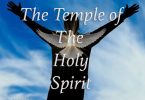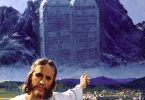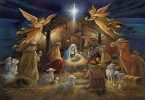 Theme: that Jesus is the shepherd who shows the way, he guides our way and he walks the way.
Theme: that Jesus is the shepherd who shows the way, he guides our way and he walks the way.
Scriptures: Acts. 2:14, 36-41; Ps. 22:1-6; 1 Pet 2:20-25; Jn. 10:1-10
A story is told about Ven. Fr. Emile Kopaun, a Czech born but brought in Kansas, USA and died during the Korean war in 1951. He got ordained for the Diocese of Wichita, Kansas and he joined the military services. He was an American military chaplain. He was assigned to the Burma-Indian borders to serve the troops during World War II.
When the US-Korean conflict began, once again he was sent to South Korean in 1950 to defend it from the North Korean troops. However, he did not fight battles with guns, he manifested his bravery on the battlefield by showing love and care to the fellow soldiers. He would nurse the wounded, administer last rites to the dying.
In the Korean battle at Unsan, he chose to remain with the wounded soldiers. He was taken as a captive with other soldiers, where he took great care of them during the captivity. He stole food and medicine for them. Sometimes he would go hungry to bed. When he was ill, the Chinese who came to help the North Korean in the battle isolated him. He was denied medication and food. He died on May 23, 1951.
When the soldiers were released from their captivity, they gave witness to the heroics of Fr. Emile Kopaun. His moral life was exalted above everything else. He did not make any difference while taking care of them. Pope St. John Paul II accepted his cause of canonization in 1993, and now he is on his path to sainthood.
Ven. Fr. Emile Kopaun followed Jesus in his life. He chose to be a priest on the battlefield. Following the example of his Divine Shepherd, Fr. Emile Kopaun guided his fellow comrades on the battlefield and in the prison. Fr. Kopaunknew the way, showed the way and walked the way to Christ.
Today’s liturgy tells us that Jesus is the Good shepherd. The fourth Sunday of the Easter is also known as the Good Shepherd Sunday and it is also Vocation Sunday in the Church. The image of Jesus as the Good Shepherd is one of the most dominating images among us. It has been partly influenced by the Old Testament. There are so many instances where God is portrayed as the Good Shepherd. It was used in the first book of the Bible (Gen. 49). Moses and all the major prophets used this imagery to depict God as a shepherd. Among these references, the Psalmist portrays God is our shepherd, and there is nothing that we shall want. (Ps. 23) It is today’s responsorial psalm and it stands out prominently in the Old Testament. Ultimately the people of Israel believed that God was their shepherd.
Jesus, while addressing the crowd, uses the same imagery to introduce himself to the crowd. The synoptic gospels heavily use this imagery. Mark says,[ the people were sheep without a shepherd (Mk. 6:35). The parable of lost sheep to the Pharisees (Lk. 15:3). The followers are exalted as the sheep to watch out for wolves. (Mt. 7:15) The righteous are the sheep who are saved (Mt. 25:32ff). John the Evangelist does not give us many parables in his Gospel but he has only one parable i.e. today’s Gospel text on the Good shepherd. He clubs two metaphors with I am statements into one. In the first parable, Jesus says that “I am the Good Shepherd” and in the second, He says “I am the gate/door”. Each of these images is repeated twice in the parable to add emphases. Through these parables, Jesus portrays his ownership of the flock and his able leadership.
It is important to know the role of a shepherd and the concept of the gate, to understand what did Jesus mean when he claimed that he is a good shepherd and the gate. Many authors have scripted responsibilities of a good shepherd. I liked Fr. Tony Kadavil’s explanation of the parable; he categorized the responsibilities into four:
1) The Good Shepherd leads the sheep to green pastures, provides them with food and water and protects them. In Palestine, the shepherd led the flock from the front, while the sheep followed.
2) He guarded them, while not allowing them to lose their way in the desert or become victims of robbers and wild animals.
3) He went in search of the lost ones to bring them back to the flock and heal their wounds.
4) He was ready to surrender his life for his sheep. Jesus compared himself to shepherd and the gate.
We can add one more. A shepherd shears the sheep that helps them to ease out their weight. In other words, he chastises his disciples.
While understanding the concept of the gate, we need to visualise the Palestine background. The shepherds pastured his sheep but brought the sheep down from the hills to protect them from the wild animals. He had sheepfold next to his house. It was surrounded by a five feet high stone wall and there was only one way to enter into the sheepfold. The shepherd himself would sleep in front of the gate in the night. If there was any danger, he would fight against the predator with his weapons. Thus, the shepherd himself was the door. Jesus tells us through these parables that he does everything possible to feed, guard and protect his folk.
St. Peter was the first among the apostles whom Jesus asked to feed his sheep after the resurrection, and this tells us that Jesus has proven that He was a true shepherd and He is the Gate of the sheepfold. In the first reading from the Acts of the Apostles, St. Peter convinced three thousand people that Jesus is the gate of salvation. He told them that there is no other way by which we can attain salvation. Jesus is the gate of salvation.
And in the second reading, once again St Peter tells us that like a true and good shepherd, Jesus suffered and died for our sins (His sheep who had gone astray), however, Jesus, out of his love, guides us back to him.
What do we need to do? We have to listen to the voice of Jesus. Today his voice is heard through his priests in the sacraments of Eucharist and Penance. His voice is heard in the Holy Scriptures. His voice is heard in the silence of our hearts. His voice is heard in incidents that take place in our lives. His voice is heard in our conversation with friends, neighbours or relatives. Even in the current pandemic madness, we can still hear the voice of Our Lord reassuring us that He is with us.
The intimacy of a shepherd and the sheep is built by the sheep’s ability to hear shepherd’s voice. The relationship between the sheep and the shepherd is defined by voice and movement. The sheep listen to the voice of the shepherd and follow him. If I am the sheep of Christ then whom do I listen to? May I lead my life after Jesus, the shepherd who shows the way, guides the way and walks the way.
Fr. Alex D’Mello






